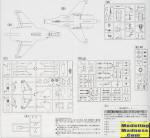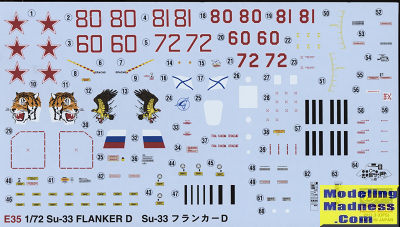
Hasegawa 1/72 Su-33 Flanker D
| KIT #: | 01565 |
| PRICE: | 2400 yen SRP |
| DECALS: | Four options |
| REVIEWER: | Scott Van Aken |
| NOTES: | 2011 boxing. |

| HISTORY |
The Sukhoi Su-33 (Russian: Сухой Су-33; NATO reporting name: Flanker-D) is an all-weather carrier-based twin-engine air superiority fighter designed by Sukhoi and manufactured by Komsomolsk-on-Amur Aircraft Production Association, derived from the Su-27 and initially known as the Su-27K. Compared with the Su-27, the Su-33 has a strengthened undercarriage and structure, folding wings and stabilators, all for carrier operations. The Su-33 has canards and its wings are larger than the Su-27 for increased lift. The Su-33 has upgraded engines and a twin nose wheel, and is air refuelable.
First used in operations in 1995 aboard the aircraft carrier Admiral Kuznetsov, the fighter officially entered service in August 1998, by which time the designation "Su-33" was used. Following the break-up of the Soviet Union and the subsequent downsizing of the Russian Navy, only 24 aircraft were produced. Attempted sales to China and India fell through. With plans to retire the Su-33 once they reach the end of their service life, the Russian Navy ordered the MiG-29K as a replacement in 2009.
| THE KIT |
 Hasegawa
has put forth several of the Flanker variants in kit form over the years. This
is a fairly good move as a lot of the parts are interchangeable between the
types. The Su-33 is quite similar to the previously previewed Su-35S. The
fuselage halves are in upper and lower halves with the wings molded into each
half. There are holes in the lower wings that need to be opened to carry the
rather considerable number of weapons that come in the kit. The kit's cockpit
includes a four piece seat with a main instrument panel and a control stick.
Decals are, as is often the norm with Hasegawa kits, provided with decals. This
is trapped between the fuselage halves.
Hasegawa
has put forth several of the Flanker variants in kit form over the years. This
is a fairly good move as a lot of the parts are interchangeable between the
types. The Su-33 is quite similar to the previously previewed Su-35S. The
fuselage halves are in upper and lower halves with the wings molded into each
half. There are holes in the lower wings that need to be opened to carry the
rather considerable number of weapons that come in the kit. The kit's cockpit
includes a four piece seat with a main instrument panel and a control stick.
Decals are, as is often the norm with Hasegawa kits, provided with decals. This
is trapped between the fuselage halves.
As with similar kits with twin widely separated engines, the intakes are in two halves with an upper intake piece that ends in the first compressor stage. On the underside of each intake are blow by doors and one can install either the open or closed versions. In the back are two piece burner cans. Though the landing gear are said to be stronger in the history section, the ones in the kit look very much like what was installed on the Su-35S. These are very nicely detailed and fit into fairly bare wheel wells. On the upper side of the fuselage is an air brake which can be posed open or closed as one so wishes. The Su-33 has canards with easily slot into the sides of the fuselage. I'd leave these off until near the end to prevent breaking them with handling. Note that these are shown as not being glued in place. It would be nice to have a one-piece radome, but we get one with a left and right half instead.
Installation of the fins, stabs and ventral strakes is pretty straight forward. Again, I'd leave off the stabs until later to make it easier to paint. The canopy can be modeled open or closed and there is a hole to open behind the seat for the open option. The last airframe addition is the outer missile pylons on the wing tips. Like many Russian jets, there are a lot of probes to attach and it may be worth holding off on these until after painting. The kit provides a variety of air to air missiles as well as paired rocket pods that can be installed on your model. Note that adding all these on the airframe would make the plane too heavy to actually get airborne from the ship with a full fuel load, so keep this in mind unless you want what most of us call an air show loadout.
 Instructions
are typical Hasegawa and use Gunze paints. For this reason some paint mixing
will be needed to duplicate one of the airframe colors. Fortunately there are
dedicated Flanker paint sets available. Note that one will need to do quite a
bit of masking due to things like the very leading edges of the wings/tailplanes
being aluminum, the steel sections of the tailplane undersides, the various
metals of the exhaust section and the white panels all over the airframe. This
as much as anything will lengthen the build time, but the results will be well
worth it. Markings are for four different aircraft, all painted the same way and
differing only in aircraft number and fin badge. Kit decals are well done and
based on my Su-35S build will work superbly.
Instructions
are typical Hasegawa and use Gunze paints. For this reason some paint mixing
will be needed to duplicate one of the airframe colors. Fortunately there are
dedicated Flanker paint sets available. Note that one will need to do quite a
bit of masking due to things like the very leading edges of the wings/tailplanes
being aluminum, the steel sections of the tailplane undersides, the various
metals of the exhaust section and the white panels all over the airframe. This
as much as anything will lengthen the build time, but the results will be well
worth it. Markings are for four different aircraft, all painted the same way and
differing only in aircraft number and fin badge. Kit decals are well done and
based on my Su-35S build will work superbly.
| CONCLUSIONS |
| REFERENCES |
https://en.wikipedia.org/wiki/Sukhoi_Su-33
June 2019 Copyright ModelingMadness.com. All rights
reserved. If you would like your product reviewed fairly and fairly quickly, please
contact
the editor or see other details in the
Note to
Contributors. Back to the Main Page
Back to the Review
Index Page
Back to the Previews Index Page